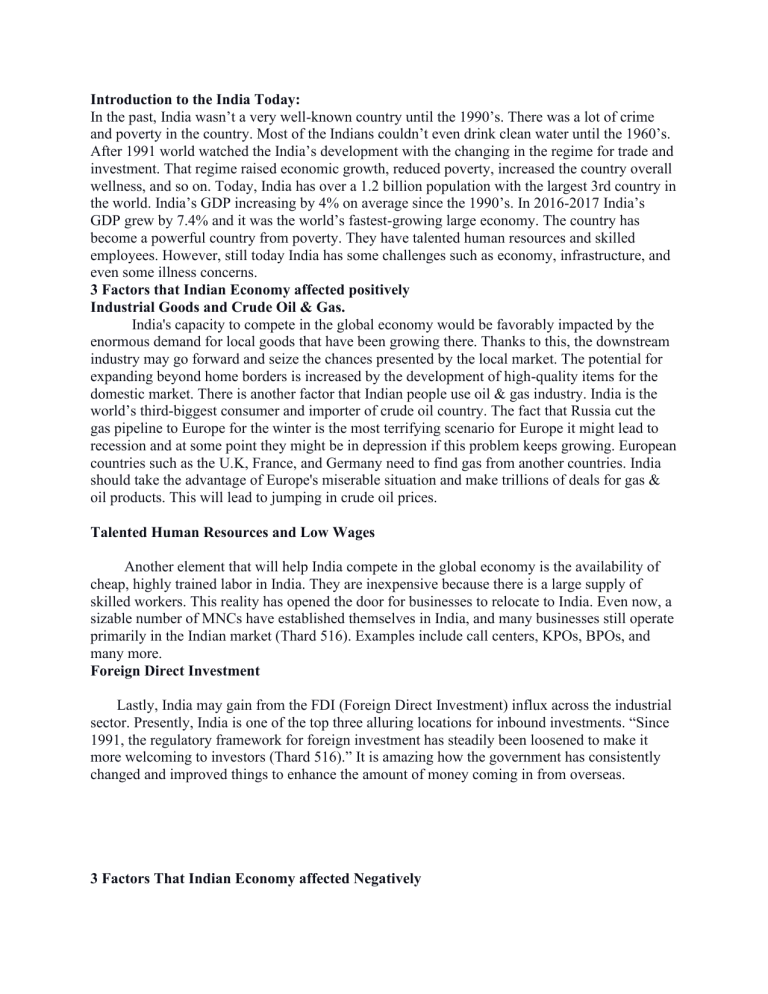Indian Economy Analysis: Strengths, Weaknesses, Opportunities, Threats
advertisement

Introduction to the India Today: In the past, India wasn’t a very well-known country until the 1990’s. There was a lot of crime and poverty in the country. Most of the Indians couldn’t even drink clean water until the 1960’s. After 1991 world watched the India’s development with the changing in the regime for trade and investment. That regime raised economic growth, reduced poverty, increased the country overall wellness, and so on. Today, India has over a 1.2 billion population with the largest 3rd country in the world. India’s GDP increasing by 4% on average since the 1990’s. In 2016-2017 India’s GDP grew by 7.4% and it was the world’s fastest-growing large economy. The country has become a powerful country from poverty. They have talented human resources and skilled employees. However, still today India has some challenges such as economy, infrastructure, and even some illness concerns. 3 Factors that Indian Economy affected positively Industrial Goods and Crude Oil & Gas. India's capacity to compete in the global economy would be favorably impacted by the enormous demand for local goods that have been growing there. Thanks to this, the downstream industry may go forward and seize the chances presented by the local market. The potential for expanding beyond home borders is increased by the development of high-quality items for the domestic market. There is another factor that Indian people use oil & gas industry. India is the world’s third-biggest consumer and importer of crude oil country. The fact that Russia cut the gas pipeline to Europe for the winter is the most terrifying scenario for Europe it might lead to recession and at some point they might be in depression if this problem keeps growing. European countries such as the U.K, France, and Germany need to find gas from another countries. India should take the advantage of Europe's miserable situation and make trillions of deals for gas & oil products. This will lead to jumping in crude oil prices. Talented Human Resources and Low Wages Another element that will help India compete in the global economy is the availability of cheap, highly trained labor in India. They are inexpensive because there is a large supply of skilled workers. This reality has opened the door for businesses to relocate to India. Even now, a sizable number of MNCs have established themselves in India, and many businesses still operate primarily in the Indian market (Thard 516). Examples include call centers, KPOs, BPOs, and many more. Foreign Direct Investment Lastly, India may gain from the FDI (Foreign Direct Investment) influx across the industrial sector. Presently, India is one of the top three alluring locations for inbound investments. “Since 1991, the regulatory framework for foreign investment has steadily been loosened to make it more welcoming to investors (Thard 516).” It is amazing how the government has consistently changed and improved things to enhance the amount of money coming in from overseas. 3 Factors That Indian Economy affected Negatively Unorganized Job Market First, there are too many political, labor, and trade unions in India, and the labor rules are antiquated. Although the law of the land is out-of-date, it is nevertheless in force in many areas of the nation. The pressure from various regulatory organizations as well as a few unregulated agencies creates a major adverse position for the firms and hampers the operation of the businesses. Industries in India are subject to stricter labor laws. These rules encourage businesses to remain small since they become mandatory as they expand. The competitiveness and productivity of labor-intensive manufacturing exports suffer when companies are unable to take advantage of economies of scale. According to Joumard et al. (para 23), “priority should be given to enacting more straightforward and adaptable labor regulations that do not differentiate based on the size of the company.” Indian Infrastructure Secondly, India needs high-quality infrastructure. India, a nation where the majority of people live in rural areas, still lacks basic access. Many marketers are reluctant to consider entering certain areas because of this. According to the video, until 1960’s a lot of Indian people had no access to the clean water. In addition, the infrastructure built in these regions is of low quality, raising concerns about its long-term viability. “The performance disparity between manufacturing as well as service exports shows that some limitations are more restrictive for labor-intensive manufacturing enterprises than for service-oriented firms” (Ignatenko et al. 23). Although there are fewer infrastructure constraints in India, some still exist. To assist Indian industrial enterprises become more competitive, the area has to execute a variety of changes, such as lowering the cost of power and improving retail tariffs' cost-reflectiveness. Indian Illness Problem Finally, India's capacity to compete in the global economy is severely threatened by the prevalence of industrial illness in the country. One of the ongoing issues the nation's industrial sector has to deal with is the rising incidence of illness. Significant amounts of loanable money from financial institutions are trapped in failing industrial units, wasting resources and hindering the industrial economy's rapid expansion. Conclusion: India is the country that everyone should pay attention in the future. They have a lot of great sources that they can use as well as lower wages. Since the world is in recession for a couple of months Countries like India can take the advantage of lower debt and increase foreign direct investment to other countries as well. On the other hand, there are some issues that India needs to fix, in order to become one of the strongest countries. For example, they need to make sure that their regulations on point, and if they need they need to regulate the market as well. Finally, their infrastructure is way behind the developed countries and this leads the country to lag too. If the country solves those difficulties there is no doubt that one day India become the center of the world. Indian Market SWOT Analysis Strengths Weaknesses • • • • A huge market for residential industrial goods A wealth of talented human resources Expanding real assets investment Inflow of Foreign Direct Investment Opportunities • Indian industries’ focus on quality • India-Made as a Global Brand • Massive export market • Indian companies' overseas investments and acquisitions • • • Workplace illness Outdate laws Deficit in quality infrastructure Threats • Countries still lagging behind • Unorganized job market Works Cited Joumard, Isabelle, Arriola, Christine and Dek, Marnix. "Challenges and opportunities of India’s enhanced participation in the global economy." (2020). Raei, Ms Faezeh., Ignatenko, Anna., and Mircheva, Borislava. Global value chains: What are the benefits and why do countries participate?. International Monetary Fund, 2019. Thard, Nishant. Globalization and Indian Market: A Swot Analysis. (2016). https://www.worldwidejournals.com/paripex/recent_issues_pdf/2016/December/globaliza tion-and-indian-market-a-swot-analysis_December_2016_9604015071_4817383.pdf. (Accessed 13th Sept, 2022).




